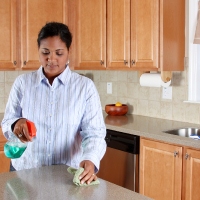 Lately it seems as if the news is filled with horror stories of food-borne illnesses. We’re all familiar with the E.Coli that can lurk in undercooked meat and salmonella in chicken. These foods are common in our kitchens, and many others are possible carriers of harmful germs.
Lately it seems as if the news is filled with horror stories of food-borne illnesses. We’re all familiar with the E.Coli that can lurk in undercooked meat and salmonella in chicken. These foods are common in our kitchens, and many others are possible carriers of harmful germs.
We can fight back by keeping a healthy kitchen. Food preparation surfaces and cooking utensils must be disinfected regularly to stop cross-contamination. Soap and water alone will not kill germs; they may only spread the germs around. Only a disinfectant can kill harmful bacteria and viruses that may be hiding in your food.
With these “best practices” for kitchen cleaning and maintenance we can prevent our families from getting sick.
- Isolate potentially dangerous foods, such as raw meat, seafood and chicken, from other foods. Clean and disinfect all surfaces and utensils with which they came in contact before preparing another food. That includes your hands!
2. Clean cooking surfaces, counters, and tabletops with a disinfecting cleaner. Handy single-use disinfecting wipes are good to keep within reach.
- Use a solution of bleach and water (1 tablespoon of bleach per gallon of water) to wash down refrigerators, freezers, and other appliances that come into contact with food. However, don’t use this on steel or aluminum surfaces. This diluted bleach solution can also be used to disinfect cutting boards, pots and pans, and cooking utensils.
4. Wooden cutting boards should first be washed in detergent, and then soaked for several minutes in a stronger bleach solution (3 tablespoons of bleach per gallon of water)..
5. If you use sponges, run them through the upper rack of the dishwasher. Or, better yet, replace them with disinfecting wipes to wipe down surfaces.
6. Use a multi-purpose spray cleaner to remove stains on walls, floors and cabinets.
7. If you have grouted kitchen tiles, use a bleach gel pen to remove grout stains.
